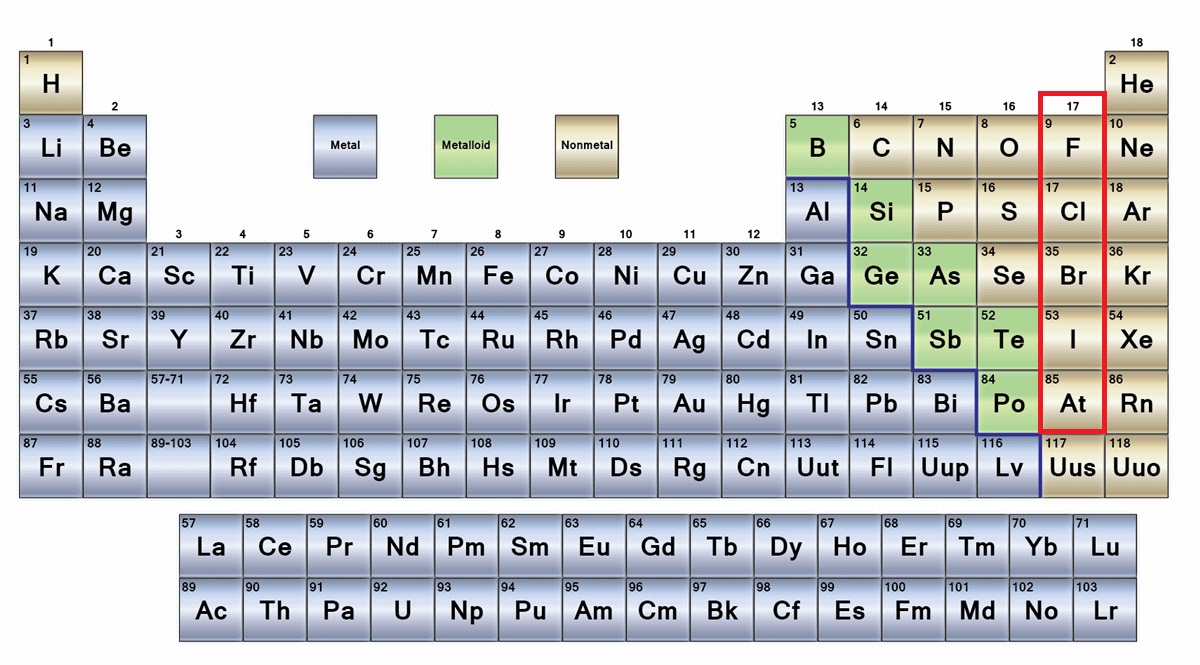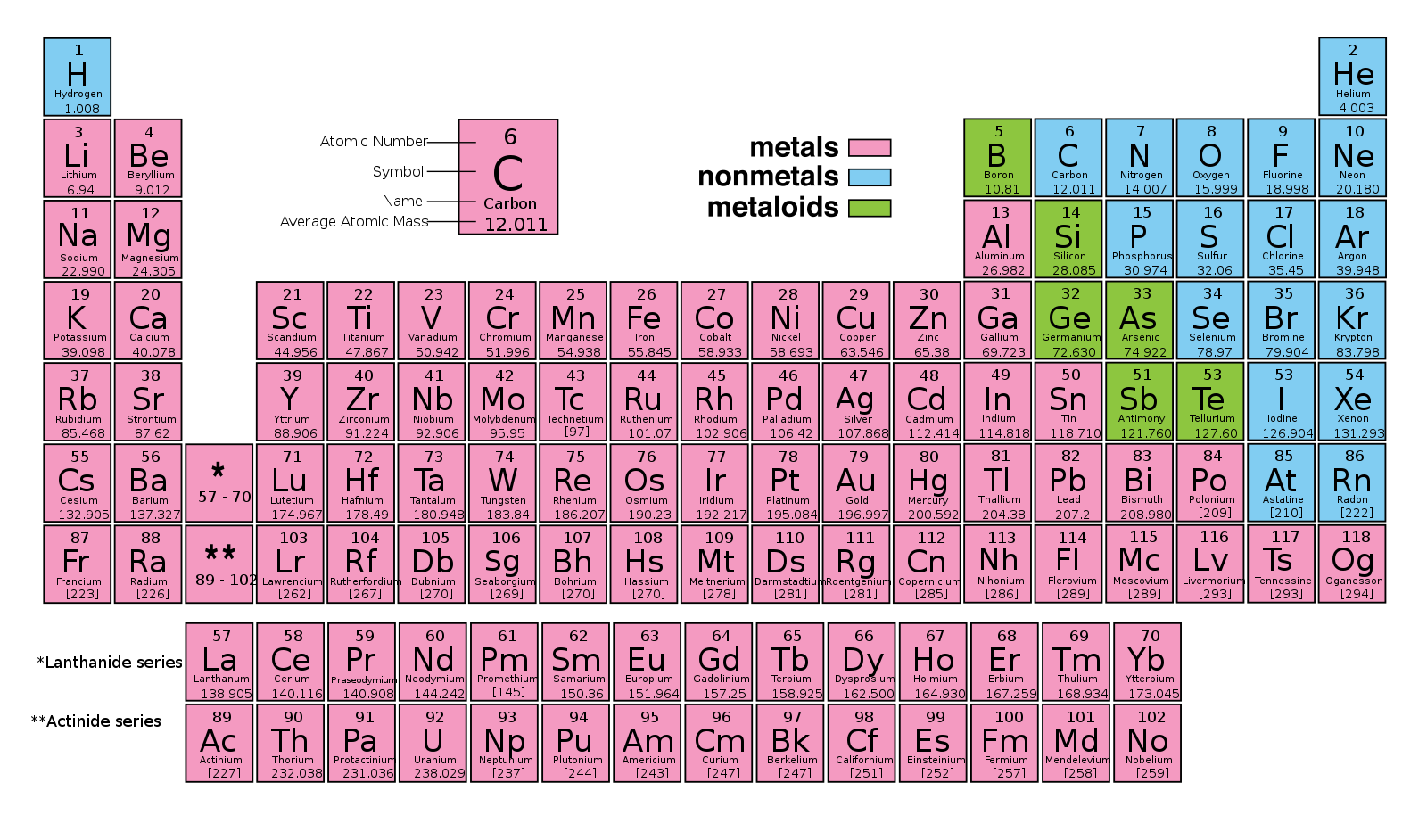Difference Between Metals, Metalloids, and Nonmetals
• Categorized under Chemistry,Science | Difference Between Metals, Metalloids, and Nonmetals
A metal is a substance with high heat and high electrical conductivity. A metalloid has some features similar to metals and some features similar to nonmetals. Nonmetals have low conductivity of heat and electricity.

What is Metals?
Definition:
A metal is a group of substances that have high electrical and heat conductivity and are malleable. Metals make up ¾ of the elements on the periodic table of elements.
Properties:
Metals are excellent conductors of electricity and are malleable meaning they can be manipulated into different shapes and forms. The metals are also able to easily lose electrons but do not gain them very easily, meaning they have a low ionization energy. Bonds produced when metals combine with other metals is usually called metallic bonds. There is a great deal of variation in how reactive metals are, and many also have a shiny appearance. Many metals also readily react with nonmetals. Elements that are metals are found mainly on the left side of the periodic table.
Examples:
Examples of metals familiar to most people include copper, zinc, and tin; aluminum is a common metal found in the Earth’s crust.
Uses:
Many metal alloys are used in manufacturing and building of structures. For instance, brass is an alloy of zinc and copper while steel is an alloy of the metal iron with varying amounts of the nonmetal carbon, along with varying amounts of other substances. Alloys always include at least one metal and are important components of structural engineering; they tend to be stronger and more durable than a single metal on its own.

What is Metalloids?
Definition:
Metalloids are substances that show properties that are in between those of metals and nonmetals with many also known to be semiconductors; this means that many metalloids are also able to conduct electricity at certain times. They are also frequently called semimetals since they may have some features of metals but are not classified as metals since they do not have all the properties, we use to designate elements as metals.
Properties:
Metalloids have intermediate levels of electronegativity and ionization, with many able to act as conductors of electricity under certain conditions. It is because metalloids have properties between both metals and nonmetals that they are positioned on the periodic table between the two other groups of elements.
Examples:
Boron, arsenic, and silicon are examples of the six elements on the periodic table that are commonly considered to be classified as metalloids.
Uses:
Certain metalloids like silicon are important in electronics because they have intermediate properties of electrical conductivity. The silicon chip forms the basis of all computer systems. Boron is an important part of many substances used in manufacturing, and when combined with silicate forms borosilicate used in glass where it protects against damage from extreme thermal changes.

What is Nonmetals?
Definition:
A nonmetal is a substance that is known to have low electrical and heat conductivity, and are not very malleable, but rather brittle. They make up much fewer of the elements of the periodic table compared with metals, but there are more nonmetals than metalloids.
Properties:
Unlike metals, nonmetals have a high ionization energy so while they can readily gain electrons, they cannot easily lose electrons. They also do not conduct electricity easily and they tend to share electrons when bonding with other nonmetals (i.e., they form covalent bonds).
Examples:
Familiar examples of nonmetals include carbon, hydrogen, and oxygen.
Uses:
Nonmetals comprise many of the biological molecules, forming the backbone of organic compounds. In fact, hydrogen, carbon, and oxygen are the most abundant atoms making up organic compounds that form molecules in living organisms. Nonmetals such as nitrogen are also important as components of fertilizers.
Difference between Metals, Metalloids, and Nonmetals?
Definition
Metals typically have a high conductivity and low ionization energy. Metalloids are intermediate between metals and nonmetals. Nonmetals have low conductivity of electricity and heat and high ionization energy.
Heat conductivity
Metals have a high heat conductivity. Metalloids have an intermediate capacity to conduct heat, while nonmetals are poor heat conductors.
Ionization energy
Metals have a low ionization energy. Metalloids have intermediate ionization levels and nonmetals have high ionization energies.
Electrical conductivity
High electrical conductivity is a feature of metals while metalloids can conduct electricity under certain conditions only. Nonmetals are poor conductors of electricity.
Examples
Examples of metals include copper, tin, and zinc. Silicon, boron, and arsenic are examples of metalloids, and oxygen, carbon, and hydrogen are examples of nonmetals.
Table comparing Metals, Metalloids, and Nonmetals

Summary of Metals, Metalloids, and Nonmetals
- Metals are good conductors of electricity and heat and have low ionization energy.
- Nonmetals are poor at conducing electricity and heat and are characterized by high ionization energy.
- Metalloids have properties that are intermediate between both nonmetals and metals.
Other FAQ
What are the main differences between metals, nonmetals ,metalloids, and noble gases?
Metals have properties such as high conductivity and low electronegativity while nonmetals have the reverse. Metalloids are intermediate in properties between both the metals and nonmetals, while noble gases are elements that occur only in a gas form; while the other substances can take on more than one form.
What is the difference between metals and nonmetals properties?
Metals are very malleable, can conduct electricity and heat and have low ionization energy, while nonmetals are brittle, do not conduct electricity or heat well and have a high ionization energy.
How are metals and metalloids different?
Metalloids do not have all the features that metals have, even though some metalloids do conduct electricity at times. Metals always can conduct electricity, are very malleable and have a high heat conductivity.
Is Iodine a metal or nonmetal?
Iodine is classified as a nonmetal.
- Difference Between Rumination and Regurgitation - June 13, 2024
- Difference Between Pyelectasis and Hydronephrosis - June 4, 2024
- Difference Between Cellulitis and Erysipelas - June 1, 2024
Sharing is caring!
Search DifferenceBetween.net :
Cite
APA 7
Osborn, D. (2021, August 20). Difference Between Metals, Metalloids, and Nonmetals. Difference Between Similar Terms and Objects. http://www.differencebetween.net/science/difference-between-metals-metalloids-and-nonmetals/.
MLA 8
Osborn, Dr. Rae. "Difference Between Metals, Metalloids, and Nonmetals." Difference Between Similar Terms and Objects, 20 August, 2021, http://www.differencebetween.net/science/difference-between-metals-metalloids-and-nonmetals/.
1 Comment
Leave a Response
Written by : Dr. Rae Osborn. and updated on 2021, August 20
References :
[0]The Editors of Encyclopedia Britannica “Metal.” Chemistry. Encyclopedia Britannica, 2021, https://www.britannica.com/science/metal-chemistry
[1]Image credit: https://commons.wikimedia.org/wiki/File:Periodic_table_(metalloids).png
[2]Image credit: https://commons.wikimedia.org/wiki/File:Periodic-Table-Metals.jpg
[3]Image credit: https://commons.wikimedia.org/wiki/File:Periodic_Table_Of_Elements.svg
See more about : metals, Nonmetals

I am so impress, to be among an intelligence environmen like this. It is my great honour, to said I do real benefited.